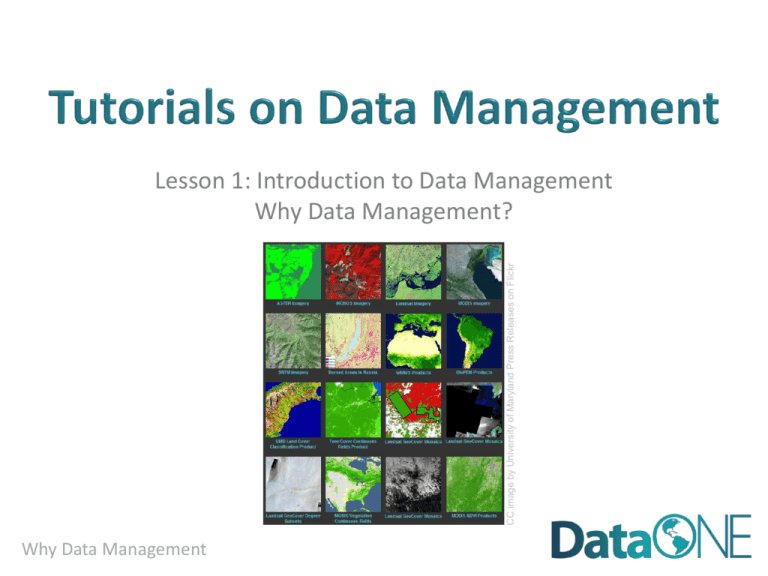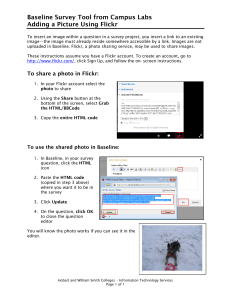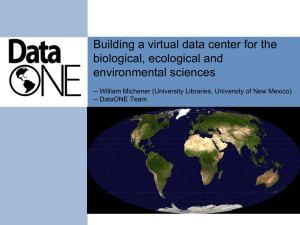
CC image by University of Maryland Press Releases on Flickr
Lesson 1: Introduction to Data Management
Why Data Management?
Why Data Management
The data world around us
Importance of data management
The data lifecycle
The case for data management
CC image by interpunct on Flickr
•
•
•
•
Why Data Management
After completing this lesson, the participant will be able to:
• Give two general examples of why increasing amounts of
data is a concern
• Explain, using two examples, how lack of data management
makes an impact
• Define the research data lifecycle
• Give one example of how well-managed data can result in
new scientific conclusions
Why Data Management
Why Data Management
Images collected by DataOne.org
Why Data Management
CC image by tajai on Flickr
Photo courtesy of
http://modis.gsfc.nasa.gov/
Photo courtesy of
http://www.futurlec.com
Photo courtesy of www.carboafrica.net
Image collected by Viv Hutchinson
CC image by CIMMYT on Flickr
Data is collected from sensors, sensor
networks, remote sensing, observations,
and more - this calls for increased attention
to data management and stewardship
1,000,000
Transient
information
or unfilled
demand for
storage
900,000
800,000
Petabytes Worldwide
700,000
Information
600,000
500,000
400,000
300,000
200,000
Available Storage
100,000
0
2005
2006
2007
2008
2009
2010
Source: John Gantz, IDC Corporation: The Expanding Digital Universe
CC image by Sharyn Morrow on Flickr
•
•
•
•
•
•
CC image by momboleum on Flickr
•
•
•
•
Why Data Management
•
•
•
•
Natural disaster
Facilities infrastructure failure
Storage failure
Server hardware/software failure
Application software failure
External dependencies (e.g. PKI
failure)
Format obsolescence
Legal encumbrance
Human error
Malicious attack by human or
automated agents
Loss of staffing competencies
Loss of institutional commitment
Loss of financial stability
Changes in user expectations and
requirements
“MEDICARE PAYMENT ERRORS NEAR $20B” (CNN) December 2004
Miscoding and Billing Errors from Doctors and Hospitals totaled $20,000,000,000 in FY
2003 (9.3% error rate) . The error rate measured claims that were paid despite being
medically unnecessary, inadequately documented or improperly coded. In some
instances, Medicare asked health care providers for medical records to back up their
claims and got no response. The survey did not document instances of alleged fraud.
This error rate actually was an improvement over the previous fiscal year (9.8% error rate).
“AUDIT: JUSTICE STATS ON ANTI-TERROR CASES FLAWED” (AP) February 2007
The Justice Department Inspector General found only two sets of data out of 26
concerning terrorism attacks were accurate. The Justice Department uses these
statistics to argue for their budget. The Inspector General said the data “appear to be
the result of decentralized and haphazard methods of collections … and do not appear
to be intentional.”
“OOPS! TECH ERROR WIPES OUT Alaska Info” (AP) March 2007
A technician managed to delete the data and backup for the $38 billion Alaska oil
revenue fund – money received by residents of the State. Correcting the errors cost the
State an additional $220,700 (which of course was taken off the receipts to Alaska
residents.)
Slide courtesy of BLM
Poor Science Data Management Example
A wildlife biologist for a small field office was the in-house GIS
expert and provided support for all the staff’s GIS needs.
However, the data was stored on her own workstation. When
the biologist relocated to another office, no one understood how
the data was stored or managed.
Cost: 1 work month ($4,000) plus the value of
data that was not recovered
CC image by DTRave on
Open Clip Art Library
Solution: A state office GIS specialist retrieved the workstation
and sifted through files trying to salvage relevant data.
Consider that the situation could have been worse, because the data
was not being backed up as it would have been if stored on a server.
In preparation for a Resource Management Plan, an office
discovered 14 duplicate GPS inventories of roads. However,
because none of the inventories had enough metadata, it was
impossible to know which inventory was best or if any of the
inventories actually met their requirements.
Cost: Estimated 9 work months/inventory
@$4,000/wm
(14 inventories = $504,000)
Why Data Management
CC image by ruffin_ready on Flickr
Solution: Re-Inventory roads
“Please forgive my paranoia about protocols, standards, and data review. I'm
in the latter stages of a long career with USGS (30 years, and counting), and
have experienced much. Experience is the knowledge you get just after you
needed it.
Several times, I've seen colleagues called to court in order to testify about
conditions they have observed.
Without a strong tradition of constant review and approval of basic data, they
would've been in deep trouble under cross-examination. Instead, they were
able to produce field notes, data approval records, and the like, to back up
their testimony.
It's one thing to be questioned by a college student who is working on a
project for school. It's another entirely to be grilled by an attorney under
oath with the media present.”
- Nelson Williams, Scientist
US Geological Survey
Why Data Management
The climate scientists at the centre of a media storm
over leaked emails were yesterday cleared of
accusations that they fudged their results and silenced
critics, but a review found they had failed to be open
enough about their work.
Why Data Management
• Manage your data for yourself:
o Keep yourself organized – be able to find your files (data inputs,
analytic scripts, outputs at various stages of the analytic process, etc)
o Track your science processes for reproducibility – be able to match up
your outputs with exact inputs and transformations that produced
them
o Better control versions of data – identify easily versions that can be
periodically purged
o Quality control your data more efficiently
Why Data Management
Why Data Management
CC image by UWW ResNet on Flickr
• Make backups to avoid data loss
• Format your data for re-use (by yourself or others)
• Be prepared: Document your data for your own
recollection, accountability, and re-use (by yourself or
others)
• Prepare it to share it – gain credibility
and recognition for your science efforts!
• Data is a valuable asset – it is expensive and time consuming to
collect
• Data should be managed to:
o maximize the effective use and value of data and information assets
o continually improve the quality including: data accuracy, integrity,
integration, timeliness of data capture and presentation, relevance and
usefulness
o ensure appropriate use of data and information
o facilitate data sharing
o ensure sustainability and accessibility in long term for re-use in science
Why Data Management
Model results
eBird
Occurrence of Indigo Bunting (2008)
Land Cover
Jan
Apr
Jun
Sep
Dec
Meteorology
MODIS –
Remote
sensing data
Why Data Management
Spatio-Temporal Exploratory
Models predict the
probability of occurrence of
bird species across the United
States at a 35 km x 35 km
grid.
Potential Uses• Examine patterns of migration
• Infer impacts of climate change
• Measure patterns of habitat usage
• Measure population trends
Slide courtesy of DataOne
Why Data Management
Images courtesy of Cornell Ornithology Lab
Here are a few reasons (from the UK Data Archive):
•
•
•
•
•
•
•
•
Increases the impact and visibility of research
Promotes innovation and potential new data uses
Leads to new collaborations between data users and creators
Maximizes transparency and accountability
Enables scrutiny of research findings
Encourages improvement and validation of research methods
Reduces cost of duplicating data collection
Provides important resources for education and training
Why Data Management
D. Lafrenière et al., ApJ Letters
A new image processing technique reveals something not before seen in this Hubble Space
Telescope image taken 11 years ago: A faint planet (arrows), the outermost of three discovered
with ground-based telescopes last year around the young star HR 8799.D. Lafrenière et al.,
Astrophysical Journal Letters
“The first thing it tells you is how valuable maintaining long-term archives can be.
Here is a major discovery that’s been lurking in the data for about 10 years!”
comments Matt Mountain, director of the Space Telescope Science Institute in Baltimore,
which operates Hubble.
“The second thing its tells you is having a well calibrated archive is necessary but not
sufficient to make breakthroughs — it also takes a very innovative group of people to
develop very smart extraction routines that can get rid of all the artifacts to reveal the
planet hidden under all that telescope and detector structure.”
Why Data Management
Plan
Analyze
Collect
Integrate
Assure
Discover
Describe
Preserve
Why Data Management
• …there are best practices…..and….tools to help!
• The following data management lessons will illustrate in
detail each stage of the data lifecycle
• Your well-managed and accessible data can contribute to
science in ways you may not even imagine today!
Why Data Management
• The data deluge has created a surge of information that
needs to be well-managed and made accessible.
• The cost of not doing data management can be very high.
• Be cognizant of best practices and tools associated with the
data lifecycle to manage your data well.
• Many benefits are associated with the act of managing
data, including the ability to find, access, understand,
integrate and re-use data.
Why Data Management
• If data are:
o
o
o
o
o
Well-organized
Documented
Preserved
Accessible
Verified as to Accuracy and validity
• Result is:
o
o
o
o
High quality data
Easy to share and re-use in science
Citation and credibility to the researcher
Cost-savings to science
Why Data Management
1.
2.
3.
4.
Bureau of Land Management. Data Management Training Workshop
(2011)
Strasser, Carly, PhD. Data Management for Scientists, February 2012
UK Data Archive. Managing and Sharing Data: Best Practices for
Researchers, May 2011
DAMA International, The DAMA Guide to the Data Management Body
of Knowledge
Why Data Management
The full slide deck may be downloaded from:
http://www.dataone.org/education-modules
Suggested citation:
DataONE Education Module: Data Management. DataONE.
Retrieved Nov12, 2012. From
http://www.dataone.org/sites/all/documents/L01_DataManage
ment.pptx
Copyright license information:
No rights reserved; you may enhance and reuse for
your own purposes. We do ask that you provide
appropriate citation and attribution to DataONE.
Why Data Management









